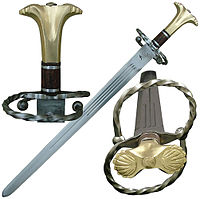Katzbalger
| Katzbalger | |
|---|---|
 |
|
| Type | Arming sword |
| Place of origin | Holy Roman Empire |
| Service history | |
| In service | 16th – 17th century |
| Used by | Landsknechte and others |
| Wars | Italian Wars |
| Specifications | |
| Weight | 0.8-1.5 kg |
| Length | 70–80 cm |
|
|
|
| Blade type | Straight, broad, flat |
| Hilt type | S-shaped guard |
A Katzbalger is a short Renaissance arming sword, notable for its sturdy build and a distinctive s-shaped or figure-8 shaped guard. Measuring 70–80 cm long and weighing 0.8-1.5 kg, it was the signature blade of the Landsknecht.
The katzbalger is a side-arm, often used by pikemen, archers, and crossbowmen as a last resort if the enemy were to draw too close for bows or pikes to be effective.
Mostly a cutting sword, the rounded tip is ill-suited to thrusting, while the flat, broad blade is specialized for cutting. As with other similar cutting-centric arming swords, it can still be using for thrusting, though it's only likely to do damage to unarmored targets.
The large, characteristic guard helps to block and parry other cutting attacks. However, its openings leave the hands vulnerable to thrusting attacks.
There are several different explanations about the origin of the name "Katzbalger": one is that it comes from the custom of carrying a sword without a scabbard, held only by a cat's skin (German word Katze means "cat", while Balg means the skin (fur) of an animal. Katzbalger means a piece made of a cat’s skin).
Another theory is that the word derives from balgen (brawling), and refers to intense, close-quarter combat like fights between feral cats. The most common translation is "cat-gutter", with an allusion to cat fight.
...
Wikipedia
